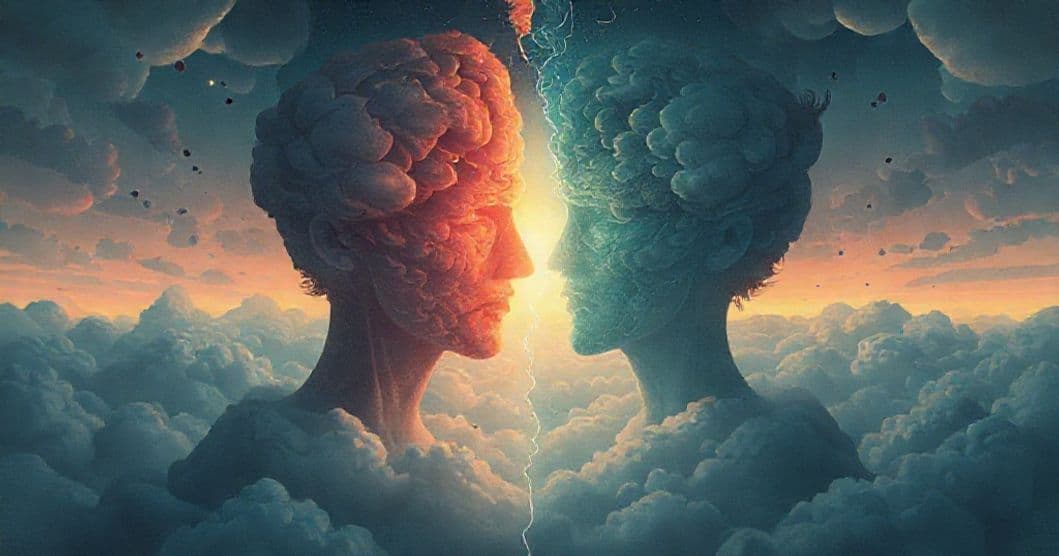Part 1: Dream Presentation
Dreams often serve as a window into our unconscious psyche, revealing truths we may not consciously acknowledge. This particular dream presents a striking visual narrative of psychological exposure, where the body’s most protected organ—the brain—becomes unexpectedly visible. The dream begins in a mundane setting: a bathroom mirror, a routine grooming task disrupted by an unexpected cut. As the cut expands across the face and the head splits open to reveal the brain, the dreamer experiences a paradoxical blend of shock and detachment, with no blood to signal the trauma one might expect. This surreal imagery invites exploration into the depths of the dreamer’s emotional landscape.
The rewritten dream narrative captures the sequence of events with sensory detail and emotional resonance: standing before the mirror, the initial cut’s appearance, the compulsion to stretch the face, the rapid expansion of the wound, the head splitting open, and the detached observation of the exposed brain. The lack of blood and the dreamer’s frozen state highlight the dream’s focus on psychological rather than physical trauma.
Part 2: Clinical Analysis
Want a More Personalized Interpretation?
Get your own AI-powered dream analysis tailored specifically to your dream
🔮Try Dream Analysis FreeSymbolic Landscape: The Language of Physical Metaphors
The head splitting open represents a profound psychological opening—an exposure of the self that feels both terrifying and liberating. In dream symbolism, the head often signifies the ego, consciousness, and sense of self, while splitting or breaking can indicate a crisis of identity or the shedding of old ways of being. The absence of blood is particularly significant: it suggests that while the dream may feel emotionally charged, there is no immediate visceral reaction or 'bloodletting' of emotional energy. This could imply a psychological numbness or an attempt to process trauma without the usual emotional discharge.
The expanding cut on the cheek mirrors how small issues can escalate into larger concerns when ignored. The act of stretching the face to the right may symbolize a forced perspective—viewing oneself or a situation from an uncomfortable angle, perhaps related to external pressures to conform or change. The brain’s exposure without skull suggests a fear of vulnerability, where the dreamer may feel their 'true self' is being laid bare to scrutiny, yet without the protection of the usual defenses.
Psychological Perspectives: Multiple Lenses on the Unconscious
From a Jungian perspective, this dream aligns with the archetype of the 'shadow'—the hidden aspects of the psyche that demand integration. The head splitting open represents the dissolution of the ego boundary, allowing access to deeper psychological truths. This process of individuation (Jung’s term for psychological wholeness) often involves confronting uncomfortable aspects of the self, and the dream’s surreal imagery may reflect the dreamer’s resistance to this process.
Freudian theory would interpret the head splitting as a manifestation of repressed anxiety. The cut and expansion could symbolize repressed anger or frustration that has been building beneath the surface, finally breaking through. The lack of blood might indicate that this anxiety is not yet fully conscious or has been numbed by emotional defenses.
Neuroscientifically, dreams process emotional memories and stressors. The visual intensity of this dream suggests the brain is working through significant emotional material, possibly related to recent stressors or unprocessed feelings. The brain’s appearance without skull might represent the mind’s attempt to make sense of overwhelming information by 'exposing' it directly.
Emotional & Life Context: The Waking World Behind the Dream
This dream likely reflects the dreamer’s current emotional state, possibly related to feeling exposed in waking life. The bathroom mirror, a space of self-evaluation, suggests concerns about self-image or how one is perceived by others. The compulsion to stretch the face could indicate pressure to conform to external expectations, while the expanding cut represents how these pressures can feel like they’re 'cutting' into one’s sense of self.
The dreamer’s frozen state during the head splitting suggests a pattern of emotional paralysis—feeling unable to respond to challenges or changes in life. The scar-covered face that repeats in their mind hints at unresolved trauma or the lingering effects of past emotional wounds. This could relate to a period of transition, where the dreamer is unsure how to navigate new responsibilities or relationships, leading to a fear of 'exposure' in these areas.
Therapeutic Insights: Embracing the Split
This dream offers an opportunity for self-reflection on vulnerability and authenticity. The absence of blood suggests that while the dream feels traumatic, the emotional impact is not as severe as it might appear. This could be a sign that the dreamer is developing resilience to emotional challenges, even if they feel stuck in the moment.
To integrate this insight, the dreamer might benefit from journaling about recent stressors and identifying any areas where they feel 'cut off' from their true selves. Mindfulness practices could help them observe their emotional reactions without judgment, allowing them to process anxiety rather than repress it. The act of 'stretching the face' in the dream might symbolize the need to expand one’s perspective, to see situations from new angles without forcing change.
FAQ Section
Q: What does it mean when the head splits open in dreams?
A: A head split often symbolizes psychological exposure or vulnerability, representing the shedding of old identities or the need to confront hidden aspects of the self. It may indicate a period of transformation.
Q: Why was there no blood in this dream?
A: The absence of blood suggests emotional numbness or a lack of immediate emotional discharge. It may indicate that the dreamer is processing trauma without overt emotional reactions, or that the issue is more psychological than physical.
Q: How can this dream help with personal growth?
A: This dream encourages the dreamer to embrace vulnerability and authenticity. By confronting the fear of exposure symbolized in the dream, they can develop resilience and self-acceptance, allowing for deeper psychological integration.
